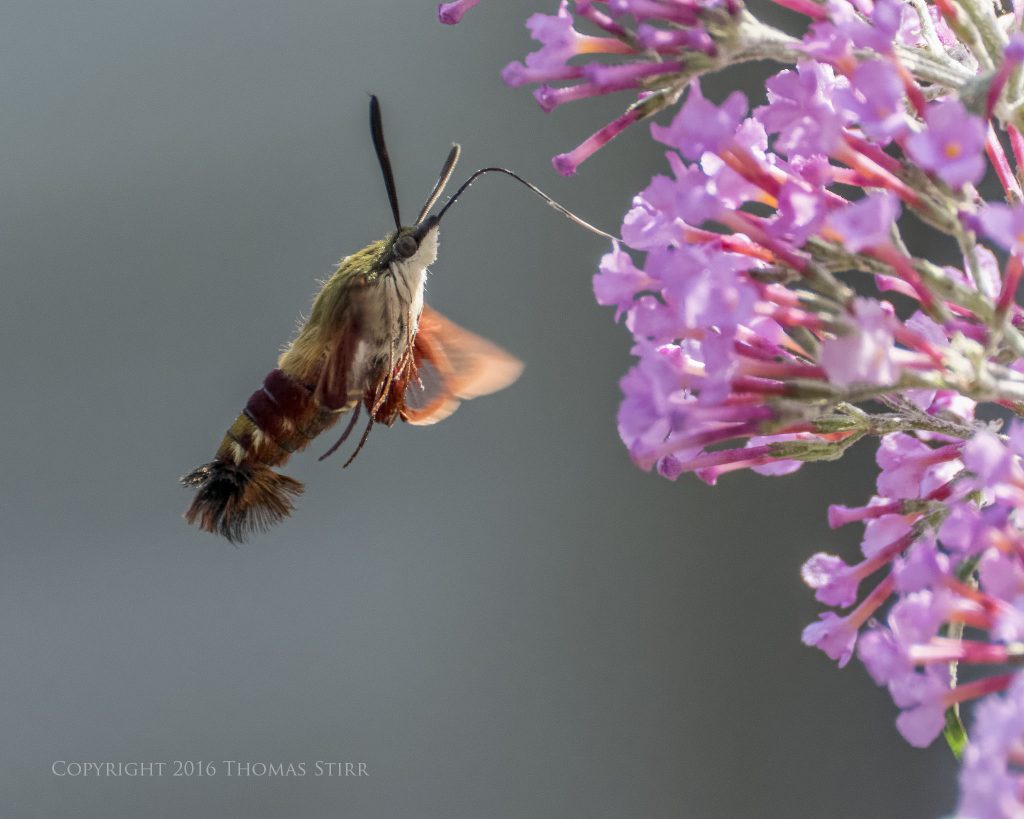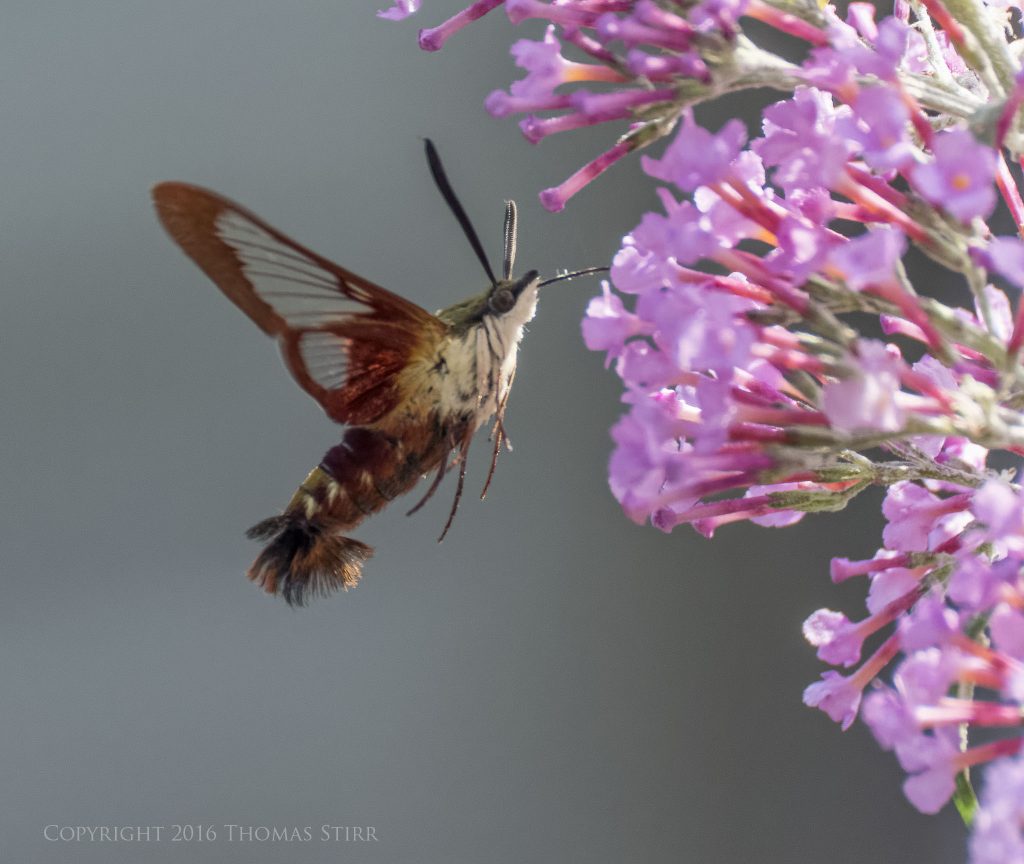A few days ago I was in my backyard waiting in vain for a hummingbird to visit when I noticed something hovering around one of our butterfly bushes. I grabbed my camera and went to investigate. Rather than photographing a hummingbird at 60 fps as I had planned, Mother Nature sent a Hummingbird Clearwing Moth instead.
NOTE: Click on images to enlarge.

The Hummingbird Clearwing Moth moth is supposed to be quite common throughout the eastern half of the United States and much of Canada, but I had never seen one before.
I was fortunate to be able to capture a couple of image runs at 60 frames per second using my Nikon 1 V2. The next three images are the initial consecutive images in one of the bursts.

The scientific name for this moth is Hemaris thysbe. It is a fairly large moth with a wingspan of 4 cm to 5.5 cm.

These moths drink nectar from a wide variety of plants such as beebalm, red clover, lilac, cranberry, blueberry, and thistles to name a few.

They feed and fly during the daytime, hovering in front of a flower when feeding the way that hummingbirds do.

There are four species of hummingbird moths in North America with the Hummingbird Clearwing Moth and the Snowberry Clearwing being the most common.

There are various species of hummingbird moths in Europe, North Africa and across Asia. In Britain they are commonly called Hummingbird Hawk-moths.
The next time you have a small, thick bodied critter hovering around your flowers check it out. It may not be a hummingbird at all, but rather a hummingbird moth.
My intent is to keep this photography blog advertising free. If you enjoyed this article and/or my website and would like to make a modest $10 donation through PayPal to support my work it would be most appreciated. You can use the Donate button below. Larger donations can be made to tom@tomstirr.com through PayPal.
Article and all images are Copyright 2016 Thomas Stirr. All rights reserved. No use, duplication or adaptation of any kind is allowed without written consent. If you see this article reproduced anywhere else it is an unauthorized and illegal use.


Dear Thomas,
Before an year or so, I had been to my friends place on western coast of India. One morning, I had photographed and videoed this one ‘very small bird’ and was lost at as no one could let me know what it was though I was sure it was not an humming bird. Through your blog I came to know its true name and what it is.
Thanks for the wonderful snaps and details!
Hi Vinayak,
I’m glad the article was helpful for you! I had no idea that my images were of a Hummingbird Clearwing Moth until I did some research and got some input from friends.
Tom
Cracking photographs again Thomas. Well done!
Thank you David!
Tom
Hi Tom –
Again, interesting post! I decided to bite the bullet and picked up a very unused V3 to augment the V1. That J5 does give great clarity and detail, indeed.
With your 60 FPS, how did you set up the rest of your shots? Did you set all your exposure factors to M, using the 1/1600, 1250 iso and f5.6 by choice? What was your auto exposure set to? Tracking or . . . .??
Cheers & thanks –
Naomi
Hi Naomi,
I had my Nikon 1 V2 set for Manual exposure and used Auto-ISO 160-3200. I set my shutter speed to 1/1600 (in retrospect I should have gone a bit faster) and aperture to f/5.6. The Auto-ISO then arrived at ISO-1250. Focus was set to AF-C with subject tracking. I used 60fps in AF-C. This setting uses the first frame to lock focus for all subsequent images in the run so I waited until the moth was hovering to feed to get my images. I also used center weighted average metering.
Tom
Thanks, Tom!
Great photos! In Europe we have a similar species, the Hummingbird hawk-moth (Macroglossum stellatarum). A detail from Wikipedia: “Hummingbird hawk-moths have been seen as a lucky omen. In particular, a swarm of the moths was seen flying across the English Channel on D-Day, the day of the Normandy landings in the Second World War.”
After the import of hummingbirds became illegal in Europe, occasions for seeing a living individuum here are rare, there are only half a dozen zoos in Germany, Netherlands and France who hold them. If someone claims to have seen a “hummingbird” in the wild, it’s almost always a Hummingbird hawk-moth. With their origin in the mediterranean, they appear in Germany only in September.
That’s why your hummingbird photos are a particular pleasure to see.
Hi Stefan,
Thanks for providing some additional information on Hummingbird hawk-moths – always appreciated!
Tom
Totally Delightful!!! I have hummingbird moths visit my garden each year. Love them. I have never tried to take any photos of them. Your shots are so good!
Thanks Joni – I’m glad you enjoyed the images!
Tom